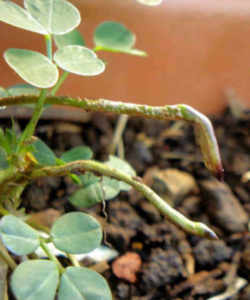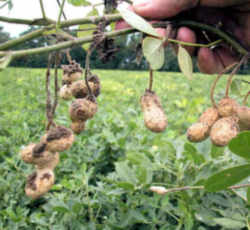
Georgia Symbols
Georgia State Crop
Peanut

(Genus Arachis L.)
Adopted in 1995
The General Assembly selected the peanut to be Georgia official state crop in 1995. Georgia produces nearly 50 percent of the total
United States peanut crop and more than 50 percent of peanuts used in the production of peanut butter. Georgia leads the nation in peanut exports.
Georgia produces nearly 50 percent of the total United States peanut crop and more than 50 percent of peanuts used in the production of peanut butter. Georgia leads the nation in peanut exports.
In 2012 Georgia farmers harvested 730,000 acres of peanuts, the official state crop, for a yield of 3.3 billion pounds. The state's most famous peanut farmer, U.S. president Jimmy Carter, and his family raised the crop for decades in Sumter County.
Georgia State Crop: Peanut

The scientific name for the common, commercially grown peanut is Arachis hypogaea L. Contrary to popular opinion, however, the peanut is not really a nut such as a pecan or walnut. It is actually a close relative of the black eyed pea in the family Leguminosae. Legumes are plants in which the roots contain nodules of nitrogen fixing bacteria which return remarkable amounts of nitrogen to the soil. Logically, the peanut is a perfect crop to rotate in with soil depleting plants like cotton and is used extensively for this purpose
The peanut plant is a sparsely hairy, taprooted, annual bush about 45 cm tall when mature. The four main botanical varieties are Virginia, Spanish, Valencia, and Peruvian Runner. They are distinguished from each other by branching habit, branch length, and hairiness. The most interesting facet of peanut growth is the development of the seeds. After the small, yellow flowers pollinate themselves, the stalks at the bases of the ovaries, called pegs, elongate rapidly and turn downward due to geotropism. The peg then buries itself several inches in the ground to mature in approximately four months .
Origin and Growing Conditions

The peanut, (Arachis hypogaea L.,) is native to South America and is believed to have originated in the areas of Brazil, Peru, and Bolivia. In its native state it is a tropical, perennial plant. Brought to the South by explorers from South America via Africa, the peanut is thought to have been grown in Georgia about a decade before the Civil War (1861-65). Despite its name, the peanut is not a true nut but a member of the legume family. The term peanut is used primarily in the United States and Australia. Elsewhere around the world, it is usually referred to as a groundnut.
The sandy soils and subtropical climate of Georgia are ideal for producing large yields of high-quality peanuts. Peanut production in Georgia is concentrated in the Coastal Plain, the area south of the fall line, which runs from Columbus through Macon to Augusta. Only a few counties in the southern half of the state, those in the southeastern corner near the Atlantic coast and the Okefenokee Swamp, do not grow peanuts.
Georgia peanuts require a long growing season of at least 150 days of warm weather. They also require about twenty-two inches of water during the growing season.
Georgia Bill
A BILL TO BE ENTITLED AN ACT
To amend Chapter 3 of Title 50 of the Official Code of Georgia Annotated, relating to state symbols, so as to provide that the official state peanut monument shall be a certain
peanut sculpture in Turner County; to repeal conflicting laws; and for other purposes.
WHEREAS, the peanut is Georgia's most important cash crop, producing millions of dollars of income, greatly enhancing the state's economy; and
WHEREAS, in Turner County, Georgia, on the west side of Interstate 75 and within the city limits of the City of Ashburn, a monumental peanut towers over passing motorists as a
tribute to this crop's importance to this state; and
WHEREAS, in 1974, with the assistance of a bequest from Nora Lawrence Smith and contributions by Gold Kist, Inc., and the Georgia Commodity Commission on Peanuts with the
assistance of Robert Davis and John R. Rogers, directors of the Turner County Chamber of Commerce, the structure took shape, a giant peanut mounted on a brick and mortar base
rising 40 feet and measuring over 12 feet in circumference; it was dedicated at a ceremony on February 17, 1974; and
WHEREAS, the dedication displayed in a plaque reads as follows:
"DEDICATION"
This monument to the peanut, Turner County's most important agricultural product, is dedicated to the memory of Nora Lawrence Smith, December 25, 1886 - July 17, 1971. Member,
Georgia Journalism's Hall of Fame, Editor and Co-Publisher of the Wiregrass Farmer, Turner County's Award Winning Newspaper and an untiring supporter of Turner County and its
agricultural economy.
Architect: A. R. Smith, Jr.
Builders: W. E. Walker/Spell Sign Company
Donors: Georgia Agricultural Commodity
Commission for Peanuts, Gold Kist,
Inc., Estate of Nora Lawrence Smith.
Sponsor: Turner County Chamber of Commerce
W. C. Youngblood, President
Monument Committee
John R. Rogers, Chairman
H. C. Barber, Jr.
John Kovac
Charles B. Perry
Dan Raines
Marvin D. Raines
February 15, 1975"; and
WHEREAS, while the monument was for several years blocked from view of the highway by vegetation, and it deteriorated in condition, the obscuring vegetation has now been
removed with the assistance of the House of Representatives and the peanut monument has been refurbished and lighted, and the monument, which has been recognized as the world's
largest peanut, proudly stands sentinel over the interstate highway proclaiming to the world that the peanut is King in Georgia; and
WHEREAS, in 1993, the Georgia House of Representatives and the Senate each passed a resolution declaring the Turner County peanut monument as the official state peanut
monument, and it is only fitting that the declaration of those bodies be memorialized in legislation.
NOW, THEREFORE, BE IT ENACTED BY THE GENERAL ASSEMBLY OF
GEORGIA:
SECTION 1.
Article 3 of Chapter 50 of the Official Code of Georgia
Annotated, relating to state symbols, is amended by striking in its entirety Code Section 50-3-72, relating to the official state crop, and inserting in lieu thereof the
following:
"50-3-72.
(a) The peanut is designated as the official Georgia state crop.
(b) The peanut monument located in Turner County on the west side of Interstate Highway 75 within the limits of the City of Ashburn is designated the official state peanut
monument."
SECTION 2.
All laws and parts of laws in conflict with this Act are repealed.
Georgia Law
The law designating the peanut as the official Georgia state crop is found in the Georgia Code, Title 50, Chapter 3, Section 50-3-72.
TITLE 50 - STATE GOVERNMENT
CHAPTER 3 - STATE FLAG, SEAL, AND OTHER SYMBOLS
ARTICLE 3 - OTHER STATE SYMBOLS
§ 50-3-72 - State crop; official state peanut monument
O.C.G.A. 50-3-72 (2010)
50-3-72. State crop; official state peanut monument
(a) The peanut is designated as the official Georgia state crop.
(b) The peanut monument located in Turner County on the west side of Interstate Highway 75 within the limits of the City of Ashburn is designated the official state peanut
monument.
Taxonomic Hierarchy: Peanut
Kingdom: Plantae – Plants
Subkingdom: Tracheobionta – Vascular plants
Superdivision: Spermatophyta – Seed plants
Division: Magnoliophyta – Flowering plants
Class: Magnoliopsida – Dicotyledons
Subclass: Rosidae
Order:" Fabales
Family: Fabaceae ⁄ Leguminosae – Pea family
Genus: Arachis L. – peanut

List Official US State Foods






